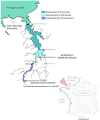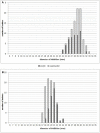Antimicrobial Susceptibility among Urban Wastewater and Wild Shellfish Isolates of Non-O1/Non-O139 Vibrio cholerae from La Rance Estuary (Brittany, France)
- PMID: 28955305
- PMCID: PMC5601046
- DOI: 10.3389/fmicb.2017.01637
Antimicrobial Susceptibility among Urban Wastewater and Wild Shellfish Isolates of Non-O1/Non-O139 Vibrio cholerae from La Rance Estuary (Brittany, France)
Abstract
The early 2000s marked the end of the Golden age of the antibiotics and the beginning of the awareness on the potential threat to human health due to the dissemination of antimicrobial resistance. As a base-line study, we investigated the antimicrobial susceptibility of 99 strains of non-O1/non-O139 Vibrio cholerae isolated from wastewater and shellfish in 2000/2001 within La Rance estuary (Brittany, France). All isolates were susceptible to amoxicillin-clavulanic acid, cefotaxime, imipenem, chloramphenicol, nalidixic acid, ciprofloxacin, norfloxacin, amikacin, gentamicin, tetracycline, doxycycline, trimethoprim-sulfamethoxazole, and erythromycin. The only resistances were to streptomycin, sulfonamides and ampicillin: 54.6% of the isolates had acquired resistance to at least one antimicrobial agent among them and only six isolates from cockles were multidrug resistant. On the basis of the distribution of a limited selection of resistance associated genes, our study shows that V. cholerae can constitute an environmental reservoir for these genes. However, none of our isolates harbored integron. This result casts doubt on the capacity of non-O1/non-O139 V. cholerae to acquire resistance-associated genes in such context, and on its potential role of indicator of the dissemination of antimicrobial resistance in the aquatic environment.
Keywords: Vibrio cholerae non-O1/non-O139; antimicrobial resistance; estuary; wastewater; wild shellfish.
Figures




Similar articles
-
Phenotypic and Genotypic Antimicrobial Resistance Traits of Vibrio cholerae Non-O1/Non-O139 Isolated From a Large Austrian Lake Frequently Associated With Cases of Human Infection.Front Microbiol. 2019 Nov 8;10:2600. doi: 10.3389/fmicb.2019.02600. eCollection 2019. Front Microbiol. 2019. PMID: 31781080 Free PMC article.
-
Antimicrobial Susceptibility of Autochthonous Aquatic Vibrio cholerae in Haiti.Front Microbiol. 2016 Oct 21;7:1671. doi: 10.3389/fmicb.2016.01671. eCollection 2016. Front Microbiol. 2016. PMID: 27818656 Free PMC article.
-
Global status of antimicrobial resistance among environmental isolates of Vibrio cholerae O1/O139: a systematic review and meta-analysis.Antimicrob Resist Infect Control. 2022 Apr 25;11(1):62. doi: 10.1186/s13756-022-01100-3. Antimicrob Resist Infect Control. 2022. PMID: 35468830 Free PMC article.
-
Antimicrobial Susceptibility of Environmental Non-O1/Non-O139 Vibrio cholerae Isolates.Front Microbiol. 2018 Aug 2;9:1726. doi: 10.3389/fmicb.2018.01726. eCollection 2018. Front Microbiol. 2018. PMID: 30116229 Free PMC article.
-
Antimicrobial resistance in Vibrio cholerae O1/O139 clinical isolates: a systematic review and meta-analysis.Expert Rev Anti Infect Ther. 2022 Sep;20(9):1217-1231. doi: 10.1080/14787210.2022.2098114. Epub 2022 Jul 13. Expert Rev Anti Infect Ther. 2022. PMID: 35790112
Cited by
-
Application of Biosensors for Detection of Pathogenic Food Bacteria: A Review.Biosensors (Basel). 2020 May 30;10(6):58. doi: 10.3390/bios10060058. Biosensors (Basel). 2020. PMID: 32486225 Free PMC article. Review.
-
The High Risk of Bivalve Farming in Coastal Areas With Heavy Metal Pollution and Antibiotic-Resistant Bacteria: A Chilean Perspective.Front Cell Infect Microbiol. 2022 Apr 7;12:867446. doi: 10.3389/fcimb.2022.867446. eCollection 2022. Front Cell Infect Microbiol. 2022. PMID: 35463633 Free PMC article. Review.
-
Prevalence of Vibrio cholerae in an Acute Watery Diarrhea Outbreak in Sulaymaniyah City, Iraq.Int J Microbiol. 2025 May 5;2025:5539834. doi: 10.1155/ijm/5539834. eCollection 2025. Int J Microbiol. 2025. PMID: 40365485 Free PMC article.
-
Phenotypic and Genotypic Antimicrobial Resistance Traits of Vibrio cholerae Non-O1/Non-O139 Isolated From a Large Austrian Lake Frequently Associated With Cases of Human Infection.Front Microbiol. 2019 Nov 8;10:2600. doi: 10.3389/fmicb.2019.02600. eCollection 2019. Front Microbiol. 2019. PMID: 31781080 Free PMC article.
-
Genetic and Phenotypic Virulence Potential of Non-O1/Non-O139 Vibrio cholerae Isolated from German Retail Seafood.Microorganisms. 2023 Nov 11;11(11):2751. doi: 10.3390/microorganisms11112751. Microorganisms. 2023. PMID: 38004762 Free PMC article.
References
-
- Alam M., Miyoshi S., Sonoda Y., Chowdhury M. A. R., Tomochika K., Shinoda S. (1997). Role of a protease in the adherence and enterotoxicity of Vibrio mimicus. World J. Microbiol. Biotechnol. 13, 37–41. 10.1007/BF02770805 - DOI
-
- Andersson Y., Ekdahl K. (2006). Wound infections due to Vibrio cholerae in Sweden after swimming in the Baltic Sea, summer 2006. Electronic 11, 1560–7917. - PubMed
LinkOut - more resources
Full Text Sources
Other Literature Sources
Molecular Biology Databases
Research Materials

